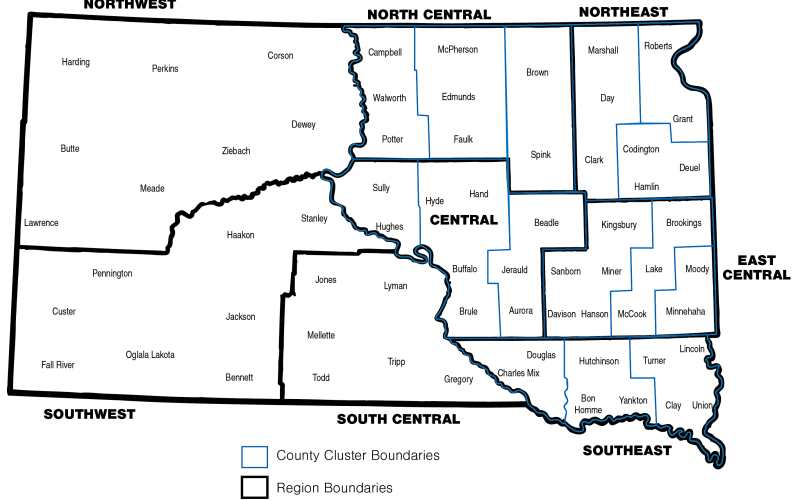The ground hog has not been a great forecaster of springs arrived in South Dakota the past couple years. April blizzards have caused problems for cattlemen calving. These problems may have carried over into the breeding season.
Reproduction is one of the biggest drivers of economic success. Cows stressed by cold, wind, snow, and mud will put energy resources into body condition maintenance and lactation prior to recycling. This delay in cycling causes a change in the calving distribution.
What is calving distribution?
Calving distribution is the number of cows calving in 21-day intervals: Day 0-21, 22-42, 43-63, 64-84 and 85-105+. The Integrated Risk Management (IRM) policy indicates cattlemen start counting on the day the 3rd cow calves. As cattlemen will tell you “The 1st one can come plus or minus 2 weeks from the breeding date.” Starting with the third cow helps take early calves into account.
As long as she’s pregnant
A common reproductive “trap” cattlemen may fall in, is the misconception that as long as the cow is bred, it doesn’t matter when she calves. High conception rates are important to the economic viability of the operation. However, cows that calve earlier in the calving season have an increased chance of weaning a larger calf compared to those that calve in the 2nd, 3rd or 4th interval. Additionally, if a large percentage of the herd calves early within the calving season as a group, the cattlemen has a larger group of similar size and aged calves to sell at weaning.
The consistent age and size are also important to those backgrounding and retaining ownership.
Age at weaning
Unless extra management steps are in place all calves are weaned within a couple days. If the generally accepted weaning age is 205 days, (Beef Improvement Federation) and calves born on March 1 hit that age target, those born in the 3rd and 4th interval are already 40-60 days younger. At 140-160 days of age those calves are considered Early Weaned and have different nutrient requirements and health considerations to take into advisement. (Early weaning article.)
Conversely, if weaning is not done until the late calves reach 205 days of age, the older calves remain on the cow longer than necessary for their optimal growth and compromise the maintenance of the dam’s body condition. As pasture resources in the fall generally decline in protein and energy levels, her nutrient consumption will be targeted toward lactation instead of maintenance.
Economic considerations as well
Nutritionally and economically there are reasons to increase the percent of cows calving in the early calving intervals. By increasing the amount of cows that calve in the 1st and 2nd intervals cattlemen can take advantage of a larger number of heavier calves at the sale barn. These heavier calves result in increased net income compared to a more variable range of calves. See example 1. This example takes into account the price slide between 550- and 650-pound steer calves. The current situation for this operation has a small percent (4%) of the cows calving at day 85-105+. However, if the operation can make a 5% improvement in their calving distribution, they may be able to recognize a $3,500 increase in calf income. The remainder of the example considers 10-25% changes.
How to change your calving interval
To make changes to calving distribution cattlemen need to consider changes and improvements to the nutrition & mineral protocols, consider increased bull power and herd synchronization.
Other Considerations
When making changes to calving distribution other items need to be considered:
- Calving date – are the facilities available adequate to calve out the increased volume of calves in the 0-21-day time frame?
- Labor - If synchronization and AI will be used, is there enough labor available for estrus detection, or sorting for timed AI? Additionally, will there be enough labor available to watch cows and new born calves, especially if there is unfavorable weather at that time?
- Feed resources – Depending on calving date, an increased number of cows with high nutritional demands at the beginning of the calving season may change feed needs. Evaluation of the ration requirements and cost should also be done when making changes to the calving season.
As the 2020 calving season gets started, the breeding season needs to be considered. A count of when cows calve need to be done to evaluate the 2020 situation. The adage of only being able to manage what is measured is true in the decision-making progress. Many producers utilize the IRM “Red Book” to keep calving, breeding, grazing, herd health, and marketing information. These books are available from Heather Gessner. Other books and apps will work to track calving dates as well.
| Current Situation | ||||||
|---|---|---|---|---|---|---|
| Cow Calved-Days | Number Calved |
Calving Distribution |
Estimated Average Weight |
Estimated Price per CWT |
Estimated Value per Calf |
Estimated Value of Group |
| Day 0-21 | 143 | 48% | 540 | $169.67 | $916.19 | $131,015.31 |
| Day 22-42 | 56 | 19% | 505 | $173.39 | $875.63 | $49,035.40 |
| Day 43-63 | 56 | 19% | 450 | $179.25 | $806.63 | $45,171.00 |
| Day 64-84 | 32 | 11% | 400 | $184.58 | $738.30 | $23,625.60 |
| Day 85-105+ | 12 | 4% | 350 | $189.90 | $664.65 | $7,975.80 |
| $256,823.11 | ||||||
| Increase First 21-day calving period 5% | ||||||
| Cow Calved-Days | Number Calved |
Calving Distribution |
Estimated Average Weight |
Estimated Price per CWT |
Estimated Value per Calf |
Estimated Value of Group |
| Day 0-21 | 158 | 53% | 540 | $169.67 | $916.19 | $144,712.37 |
| Day 22-42 | 56 | 19% | 505 | $173.39 | $875.63 | $49,035.40 |
| Day 43-63 | 56 | 19% | 450 | $179.25 | $806.63 | $45,171.00 |
| Day 64-84 | 29 | 10% | 400 | $184.58 | $738.30 | $21,447.62 |
| Day 85-105+ | 0 | 0% | 350 | $189.90 | $664.65 | - |
| $260,366.38 | ||||||
| Increase First 21-day calving period 10% | ||||||
| Cow Calved-Days | Number Calved |
Calving Distribution |
Estimated Average Weight |
Estimated Price per CWT |
Estimated Value per Calf |
Estimated Value of Group |
| Day 0-21 | 173 | 58% | 540 | $169.67 | $916.19 | $158,409.42 |
| Day 22-42 | 56 | 19% | 505 | $173.39 | $875.63 | $49,035.40 |
| Day 43-63 | 56 | 19% | 450 | $179.25 | $806.63 | $45,171.00 |
| Day 64-84 | 14 | 5% | 400 | $184.58 | $738.30 | $10,410.03 |
| Day 85-105+ | 0 | 0% | 350 | $189.90 | $664.65 | - |
| $263,025.85 | ||||||
| Increase First 21-day calving period 15% | ||||||
| Cow Calved-Days | Number Calved |
Calving Distribution |
Estimated Average Weight |
Estimated Price per CWT |
Estimated Value per Calf |
Estimated Value of Group |
| Day 0-21 | 188 | 63% | 540 | $169.67 | $916.19 | $172,106.48 |
| Day 22-42 | 56 | 19% | 505 | $173.39 | $875.63 | $49,035.40 |
| Day 43-63 | 55 | 18% | 450 | $179.25 | $806.63 | $44,485.37 |
| Day 64-84 | 0 | 0% | 400 | $184.58 | $738.30 | - |
| Day 85-105+ | 0 | 0% | 350 | $189.90 | $664.65 | - |
| $265,621.25 | ||||||
| Increase First 21-day calving period 20% | ||||||
| Cow Calved-Days | Number Calved |
Calving Distribution |
Estimated Average Weight |
Estimated Price per CWT |
Estimated Value per Calf |
Estimated Value of Group |
| Day 0-21 | 203 | 68% | 540 | $169.67 | $916.19 | $185,803.53 |
| Day 22-42 | 56 | 19% | 505 | $173.39 | $875.63 | $49,035.40 |
| Day 43-63 | 40 | 13% | 450 | $179.25 | $806.63 | $32,426.33 |
| Day 64-84 | 0 | 0% | 400 | $184.58 | $738.30 | - |
| Day 85-105+ | 0 | 0% | 350 | $189.90 | $664.65 | - |
| $261,265.26 | ||||||


